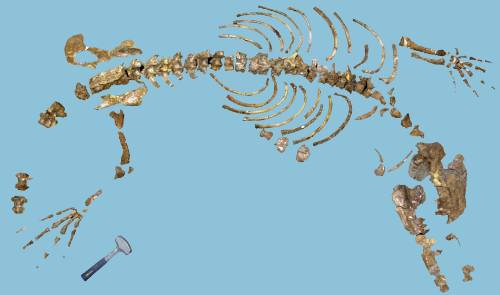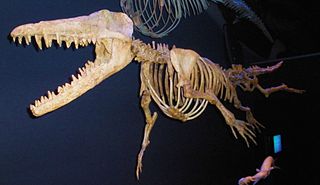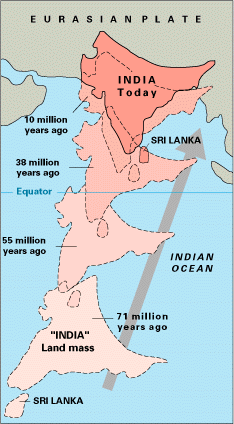Ambulocetus
Online Biology Dictionary

|
| The only known specimen of Ambulocetus. (Higher resolution image) Note the poor preservation of the limb bones, pelvis, and snout. The scapula and humerus are unknown even from fragments. Source: Thewissen Lab website. |
|
|
EUGENE M. MCCARTHY, PHD

|
|
A typical reconstruction based on the fragmentary actual skeleton shown at the top of this page. Image: Wikimedia, Ghedoghedo. |

|
| During the Eocene, Pakistan was isolated on the Indian Plate in the middle of the Indian Ocean. |
Ambulocetus, which means "walking whale," is the name given to a creature that has been widely accepted as an ancestor of whales. It lived about 50 million years ago, during the early Eocene. This animal is known, however, solely from a single, partial skeleton, that of an individual about 3 meters (~10 feet) long (see image at the top of this page; high resolution image). A typical reconstruction based on this partial skeleton is shown at right.
The specimen was found in the Upper Kuldana Formation of eastern Pakistan, which was a coastal area during the Eocene due to the position of Pakistan on the Indian Plate. The discovery team was led by anatomist Johannes Thewissen (Northeastern Ohio University College of Medicine), who popularized the idea that this creature was an early, amphibious ancestor of whales. The actual evidence for such a claim, however, is actually rather meager. Here are the few points usually cited in support of this assertion:
-
It is supposedly whale-like because it had a nose that allowed it to swallow underwater. However, human beings and many other non-marine organisms can swallow underwater. Moreover, as can be seen in the figure above (to view a high resolution image, click here), the snout of the single known specimen was not preserved.
-
The periotic bone, which surrounds the inner ear in mammals, was supposedly whale-like, resulting in enhanced hearing in water. But no one actually knows how well these creatures could hear, whether in water or out of it. Moreover, little or nothing is usually said about the great dissimilarity between all of the other features of this animal and those of a whale.
-
Its teeth are alleged to be like those of a whale. But the jaws of the single individual known (again see the figure above, click here to enlarge) are highly fragmented, and the few teeth preserved appear to be differentiated (that is, unlike those of toothed whales).
- It is asserted that this animal's hindlimbs were ill-adapted to terrestrial locomotion. But the limbs — and the pelvis — are so poorly preserved that it seems there is no clear evidence bearing on this point.
An alternative, and far more plausible, explanation of the origin of whales is given elsewhere on this website.
An Ode to Ambulocetus
by Gene McCarthy
Ambulocetus was a whale Ambulocetus had no tail. But he had legs, and he had feet, (Though his bones are incomplete). No flippers had he, nor a fluke, And yet this earns him no rebuke. He couldn't spout. He didn't swim. Perhaps he's just some scholar's whim? Was he a true ungulate? Or did someone bungle it? |
Most shared on Macroevolution.net:
Human Origins: Are we hybrids?
On the Origins of New Forms of Life
Mammalian Hybrids
Cat-rabbit Hybrids: Fact or fiction?
Famous Biologists
Dog-cow Hybrids
Prothero: A Rebuttal
Branches of Biology
Dog-fox Hybrids